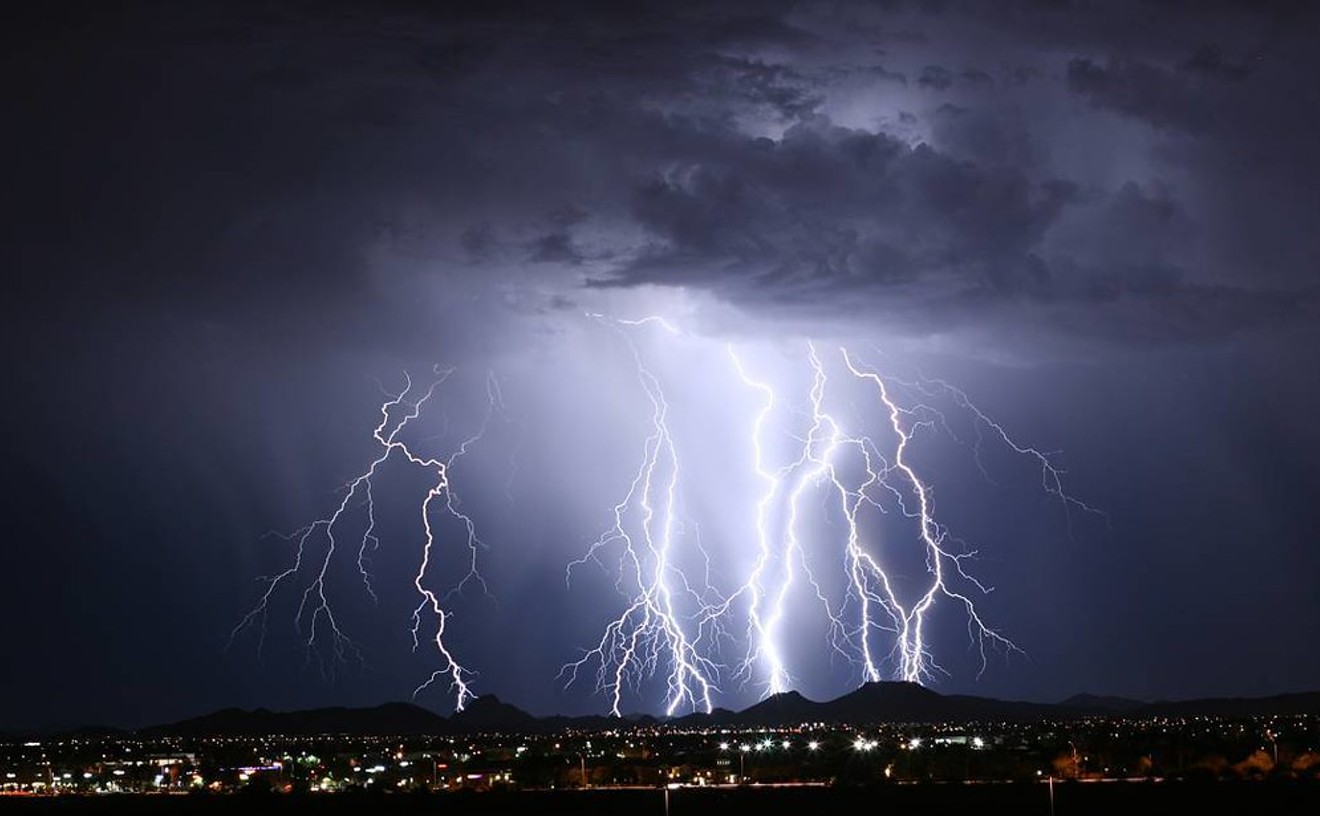Last weekend, more than 50 people sat on folding chairs in the Andre House dining room to discuss, among other things, the upcoming closure of the Men's Overflow Shelter March 31.
The community event was hosted by the Maricopa Alliance for Shelter, and Housing and began with comments from Bruce Ligget, director of the Maricopa County Department of Human Services; Father Tom Doyle of Andre House; and Mike Trailor, director of the Arizona Department of Housing.
All three expressed concern about homelessness in Phoenix, a commitment to finding solutions, and disgust with the current conditions endured daily by hundreds of homeless men and women in Phoenix.
If you've ever been to Madison Street between 11 and 12 Avenues in the early evening, you know what they're talking about-- the long line of men waiting in line across the street from the Human Services Campus of the Central Arizona Shelter Services to get into the MOS. The queue starts by the front door, follows the length of the cracked sidewalk, and then snakes around the corner toward Jefferson Street.
Hundreds of men just wait--some smoke cigarettes, others lean against the chainlink fence or sit on piles of their belongings. These days, the line starts forming at 2 p.m., even though it won't start moving until the doors to the MOS open at 6 pm. A lot of people skip the free dinner offered at a nearby church to keep their place in line.
The MOS building once housed county records, and is squat, bland, and mostly windowless. After many years of use as a "temporary" shelter, the inside smells like urine and that unmistakable odor of humans who don't have regular access to bathing and laundry facilities. It's the kind of place that smells so bad staff will ask you two or three times if you're sure you really want to go inside.
The MOS has been a contentious issue in Phoenix since it opened 10 years ago. During a heat wave that killed 30 homeless men and women in a two-month period, CASS got permission from the county to use the empty building as an emergency solution. Mark Holleran, CEO of the shelter service, says "we had 110 people laying on the floor the first night."
The shelter was never intended to be permanent, but "more and more people were showing up" so its door remained opened. At times, 300 men have slept inside, head to toe on thin, fraying green mats.
"Philosophically, the MOS isn't a good idea or a solution," Holleran says. "We know housing works for the chronically homeless." He adds that CASS has had a lot of success implementing the Housing First strategy--the one that famously put 72 percent of Utah's homeless population into stable home situations in just nine years--but that the community will to do it in Phoenix doesn't exist yet.
In January 2014, the state fire marshal found five code violations in the MOS, and "the county decided that [fixing the building wasn't] a good investment," Holleran explains. "I'm all for it going away, as long as we have a plan to replace it."
As of March 1, the number of men permitted to sleep in the MOS dropped from 120 to 80, a number already halved from what it served a few months ago. And the clock is ticking for these spots; come April 1, the building will be locked.
Watch the MOS line around 6:30, and you'll see people at the end pick up their belongings and walk toward the East Lot en masse. As the quota of people allowed in dwindles, the group of people turned away grows.
The MOS may be "unfit for human habitation," but it's a lot nicer than the East Lot, which opened in April 2013 as a response to the shortage of spaces in the MOS.
"We tried not to use the parking lot initially," Holleran says, "but in the early spring of 2013, the police asked if we would reconsider."
The neighborhood had become a public-health and public-safety disaster because men and women who came to the campus during the day to access its services had nowhere to go at night when the gates to CASS closed. All night long, local residents called 911 about screaming people, violence, and other medical emergencies. During the day, they complained to the police about human feces and urine in alleyways and by dumpsters, visible drug use, and violence.
Opening the East Lot actually did quite a bit to solve these problems--the limited bathroom facilities, off-duty police officers standing guard, and EMTs have saved the city many thousands of dollars in first-responder and emergency-room visit costs.
This being said, Americans call situations like the East Lot "humanitarian catastrophes" when they happen in other countries. There are rats, bed bugs, bird feces, mold--many at the MASH meeting referred to it as a "disease cesspool" and a "Petri dish." There are a lot of drugs--"you can smell the crack and marijuana," a former-inhabitant of the lot said. Women are frequently assaulted, despite having a cordoned area. Fights break out. People get stabbed.
The East Lot literally is just a fenced-in asphalt parking lot. Some call it "the cage." By the wall closest to the MOS, there are a handful of porta potties--fewer than 10 for the 300 to 400 hundred people who stay there every night. A few feet away are two containers filled with water, ostensibly for drinking and hand-washing. There is some toilet paper available, but many just try to stay away from the area.
"No one is defecating elsewhere or dumping trash because they want to," an East Lot inhabitant said at the MASH meeting. "We have no provisions." For a city that procured portable toilet facilities and garbage cans when it hosted the Super Bowl, this should not be the problem it is.
Some CASS employees talk about the East Lot being "bi-polar" and having a pulse of its own--you never know what kind of night it will be. "I wouldn't spend a night there," Father Doyle says. He works at Andre House, interacting daily with the people who sleep in the lot. "I'm sorry I can't give solidarity like that, but I just don't feel safe."
Let's be clear: No one in CASS (or in most any level of government) thinks the MOS and the East Lot are acceptable situations or solutions. But the alternative is even less acceptable, and no one is offering a concrete plan. Behind the scenes, non-profit and faith-based groups also are looking for solutions or temporary fixes.
"A lot of what we do is public health and public safety," Holleran says. "We deal with some really challenging issues, but we've created a system that seems to manage it well."
The MOS and East Lot also serve another important purpose: They bring people into the CASS program. Maintaining a bed in the CASS shelter means daily check-ins and property searches, and it means chores and accountability.
"Some people aren't necessarily ready for the rules that go along with [the shelter]," explains Lindsey Roberts, communications manager at CASS. The MOS and East Lot "are not the answer to homelessness, but it's a place people can be, and we can build a reputation with them so that they trust us."
It has actually become an important part of the CASS strategy, allowing people who otherwise never would approach the main campus to enter the system slowly. There's a basic check-in procedure for the MOS--you need a CASS campus ID, for instance--but people don't get turned away for being drunk or high. Employees will confiscate any alcohol, drugs, and weapons they see, but as long as you're not disturbing anyone, there are really very few rules. "You've gotta pick your battles," explains a CASS employee.
There are even looser rules for the East Lot. "It's about getting people to tomorrow so they're not inflicting harm on themselves or others," Roberts says. Before February 9, there was no check-in process whatsoever, but now men and women must give their name and date of birth. (Anecdotally, two CASS employees say things have been calmer since then. Although, they add, it doesn't mean the more rowdy people disappeared--they'd rather be out on the streets than put their names on a list.)
When it comes to homelessness, there are long-term solutions, short-term solutions, and emergency solutions. The MOS was an emergency solution many years ago, and the East Lot was an immediate response to an overwhelming excess of people in the overflow shelter. "There needs to be more urgency," Father Doyle says. "Urgency to express the scale of this."
If last week's MASH meeting was any indication, there's a lot more talk about solutions than plans to do anything. Bruce Ligget of the Human Services Department told the audience, "We've got a lot of options that we're looking at. But nothing is pinned down yet." Both he and Trailor of the Department of Housing emphasized that despite finding the situation "inhumane," the parking lot is not closing.
That's all well and good, but CASS' contract on the East Lot is up June 30. Holleran tells New Times in a statement: "The state and the county have indicated that they want to continue operations of the East Lot. However, we are unaware of any contracts that have been executed to provide for that at this time."
Which is to say, come July 1, there is no plan. "What happens then?" he says.
It's the absence of a plan that has community members so outraged--"the county is always talking about making a plan, or how they're working on a plan," a CASS employee says. He, like others, is frustrated.
Everyone is dancing around the issue," Rabbi Shmuly Yanklowitz, says. "They claim they will do some sort of alternative housing, but nothing has been done. You can't close something down before you have an option in place."
Other temporary solutions were briefly mentioned at the MASH meeting--an old Navy Facility by I-10, for instance. But Trailor said when he inquired about the space, he was told it would be a two-year process. "There's a lot of red tape involved."
Of course the county doesn't want homeless people sleeping in an unsafe building or a dirty parking lot. But the argument activists make is that even though a band-aid isn't a solution, it's better than nothing.
"[Yet] you have to ask," Holleran likes to say, "is a crummy building and a parking lot the best we can do?"
Got a tip? Send it to: Miriam Wasser.
Follow Valley Fever on Twitter at @ValleyFeverPHX. Follow Miriam Wasser at @MiriamWasser.










